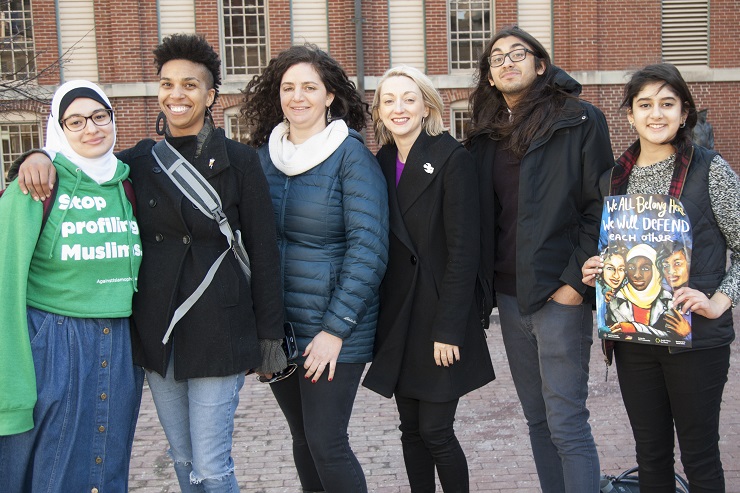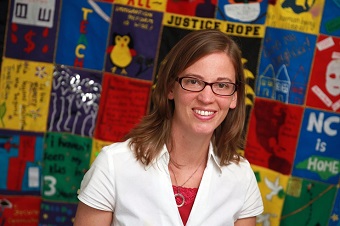
We All Belong Here press conference Larry Gindhart / AFSC
Lori Fernald Khamala is the director of the North Carolina Immigrant Rights Program for the American Friends Service Committee and also serves as the coordinator of AFSC’s Sanctuary Everywhere initiative. One aspect of this initiative is our Sanctuary Spaces project, in which AFSC highlights non-traditional examples of sanctuary spaces that are created by and for targeted communities. In this introduction to the multi-piece series, I talked with Lori about the concept of sanctuary spaces as a response to oppression, and why it’s important to lift those spaces up.

Christina: What is the Sanctuary Spaces Project?
Lori: Within our Sanctuary Everywhere initiative, AFSC is training and mobilizing people to resist unjust policies targeting communities of color. But in addition to resisting, we can’t lose sight of the world we ultimately want to create. The Sanctuary Spaces project highlights spaces created by and for targeted communities where folks feel safe and where their humanity is honored. The public thinks of sanctuary as something that happens in churches, for undocumented immigrants. But we want to broaden the notion of who sanctuary is for and where it can happen.
Christina: What kind of work is involved in Sanctuary Everywhere?
Sanctuary Everywhere is an initiative of AFSC that equips people with the tools to increase safety for targeted communities, particularly for Black, Muslim, and undocumented communities. We recognize the interconnectedness of many targeted communities across the country and want to lift that up, as well. A lot of the work in Sanctuary Everywhere is about how people of color (POC) can defend themselves in this very hostile environment, and how allies can effectively support those communities.
We have work that focuses on knowing your rights. We are training youth to respond to Immigration and Customs Enforcement (ICE) raids and police harassment. We're training Quakers and allies on how to be effective, using accompaniment strategies. We're working with people on how to offer congregational sanctuary and how to do bystander intervention. These are all really important aspects of how we are resisting the oppression of our current administration.
At the same time, there's a really important need to not just resist against oppressive systems but also build new spaces where people feel safe and comfortable and where their whole humanity is acknowledged.
Christina: How is the Sanctuary Spaces project shifting the narrative around Sanctuary?
Lori: We know that in today's political environment, most people associate sanctuary with congregations that courageously shield immigrants from deportation. AFSC supports this, and in fact, in my state of North Carolina, we have the highest number of public sanctuary cases in the nation right now, and our office has been involved in several of these cases. But the focus of the Sanctuary Spaces project is to lift up creative and non-traditional programs and spaces that are being created by and for impacted communities to keep themselves safe. For example, several AFSC programs working primarily in Black communities have started community gardens and urban farms, and what we've heard from our staff and our program participants in these locations is that in communities where residents lack access to healthy food, this is an issue of community safety and survival. This work of reclaiming the land and growing food to feed themselves is creating a sanctuary space for the community.
Christina: Who else benefits from being in sanctuary spaces?
Lori: I remember when Lewis Webb, an AFSC staff member in New York City, first described his office environment. The NYC program works with people who are currently or formerly incarcerated, and there are myriad ways that folks with a record are prevented from having access to lead full lives — like the box on employment applications that you have to check if you have been convicted of a felony or have served time and the housing options that are off limits to many formerly incarcerated individuals. Lewis talked about their office as a space where people can come and just be who they are without having to worry about being harassed by police on the street, or about anybody asking them to check boxes that are defining how human they are or not. I think that sanctuary spaces are those that allow people to be their whole selves. Targeted communities are already creating, and have always created, these spaces where they can thrive in spite of systems and institutions that try to crush their humanity, and those are the kind of spaces we want to lift up and emulate.
My background is in the immigrant rights movement. And since the Trump election, I have seen a huge surge in interest and support by white progressives in wanting to support immigrants targeted by ICE. Which is great — we need all the support we can get. At the same time, I haven’t witnessed the same level of support expressed for Black communities, who continue to be targeted — both intentionally and unintentionally — at every level of government. Through Sanctuary Everywhere, we want to name that there isn’t just one community that needs sanctuary, we need to stand up for and with all targeted communities.
Christina: You’ve spoken about the community gardens and the NYC office as a sanctuary space. What other form can sanctuary spaces take?
Lori: Another example that we are planning to lift up through our series are Freedom Schools; a project of AFSC in many different vocations. As we have learned from our programs actually working on congregational sanctuary for immigrants, the most powerful part of congregational sanctuary is not what happens inside the building, but it’s the community that is formed and the bonds and the commitment to each other that is formed. And so, when I started talking to our staff members in programs that had nothing to do with immigration, people started describing the same kind of feeling that some Freedom School participants, for example, describe. And they keep coming back every year because it's often the only place where they really feel that kind of security and are seen as whole human beings.
Sanctuary sustains hope and something more than that, it literally might sustain people's lives. Our government is tearing apart immigrant families by detention and deportation, tearing apart Black families by police violence and mass incarceration and tearing about Muslim families apart by surveillance and the Muslim ban. We have an opportunity to stand up for each other and people are creating the spaces in which they can be sustained, where their families can be sustained, where communities can be sustained.
We hope people will be inspired by the communities that are creating sanctuary spaces and we hope that we will shift people's thoughts about who deserves sanctuary and what sanctuary means. We hope that it will inspire people to go about creating their own sanctuary spaces and identifying where those spaces already exist and supporting them. We want to create sanctuary everywhere so that no one needs sanctuary anywhere.
Through this project, we also hope to generate dialogue and engage with the broader community and create spaces for people to share what creative forms of resistance they are witnessing in their communities and how they are creating sanctuary. There's a movement across the country of organizations led by people of color like Mijente and BYP100 that have been taking the lead on defining the concept of Expanded Sanctuary. There's a project called Freedom Cities that is based on a more inclusive notion of what sanctuary cities looks like. We’ve been talking to ally groups that support the vision of Expanded Sanctuary, like Church World Service and the Unitarian Universalists, about how we can work together to shift the broader perspective on sanctuary.
We will continue to support and work to grow the congregational sanctuary movement, while at the same time really recognizing that the sanctuary movement has to expand beyond the current perception of what sanctuary is.
Christina: Absolutely, the faith aspect of this work is important too. Thank you so much for sharing all this valuable information about this project — I'm really excited about it.
Read more about how communities have taken steps to create Sanctuary Spaces here.
Related Posts
Sanctuary Spaces: A place for healing from incarceration - part 1
Sanctuary Spaces: A place for healing from incarceration – part 2
Sanctuary Spaces: Pushing back oppressive systems from the inside out - part 1
Sanctuary Spaces: Pushing back oppressive systems from the inside out - part 2
A sanctuary atmosphere: creating safe, emotional and mental space for people in solitary